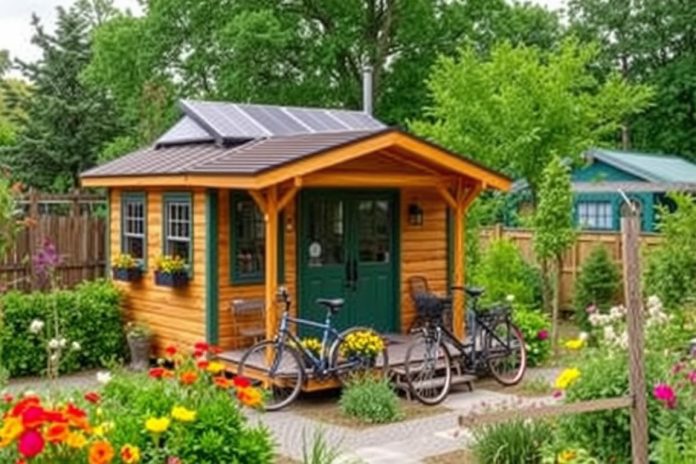Millions of moderate- and low-income families live in affordable homes without help from the government. This fact shows there are ways to find affordable homes that many don’t think about. Whether you’re dealing with a small, expensive city apartment or looking for a bigger suburban home, knowing about affordable housing can help you save money and improve your life.
Looking for affordable housing means checking out areas that aren’t as popular. If you look past places like San Francisco’s Mission district or Manhattan’s Village, you could find affordable homes in Fresno or in New York’s outer boroughs. These places have much lower living costs. And if you’re open to moving further, the South and Midwest could be cheaper options because homes there usually cost less than on the coasts.
In less wealthy areas like inner-city Detroit, housing prices are extremely low, which attracts many young people and students. On the other hand, places like Manchester, N.H., offer affordable living but also have a stronger local economy.
Some affordable housing comes from for-profit developers. They build low-income homes as part of their projects to meet the rules of local or state governments. This way of developing not only provides affordable homes but also brings different people together in one community.
Keeping housing affordable is key in places where rents are quickly going up. It helps people like seniors with fixed incomes, people with disabilities, and those who have been homeless get safe and stable housing. Explore further to find out more about affordable housing and how you can help address the need for low-cost options.
Key Takeaways
- Venturing beyond high-demand urban centers can reveal hidden affordable housing opportunities.
- Considering relocation to the South or Midwest offers substantial savings due to lower average home prices.
- Economically depressed areas can offer unique, affordable living solutions for young professionals and students.
- For-profit developers contribute to affordable housing by meeting local or state government requirements.
- Affordable housing is essential for supporting vulnerable populations and maintaining community stability.
Finding Affordable Housing: Explore Viable Areas and Options
Finding a cheaper place to live can mean moving to new areas or looking into different kinds of homes. The housing market is always changing, and with it, affordable options are becoming more available.
Consider Relocating to Less Popular Neighborhoods
Moving to less known areas can help you find cheaper places to live. Skipping places with high demand lets you find better prices. For example, cities like Detroit and Cleveland attract artists and young pros with their low costs.
Explore Economic Depressed Areas
Areas facing economic challenges can also be affordable. They may not seem as attractive as big cities, but the savings can be big. Places in the South and Midwest offer low rents and chances to buy homes. Thanks to government help and housing incentives, these areas are worth considering.
Look at Build to Rent Communities
Build to rent communities are built just for renters and come with special features. Programs like the Low-Income Housing Tax Credit and Section 8 make these places more affordable. They offer long-term solutions for people with lower incomes.
To understand these options better, here’s a quick guide to some housing supported by the government:
| Housing Type | Key Features |
|---|---|
| LIHTC Properties | Reduced rents through tax credits |
| Section 8 Housing | Rental assistance for eligible low-income tenants |
| Public Housing | Income-based rent options |
| Nonprofit and Community-Based Housing | Funded by subsidies, grants, and donations |
| Accessory Dwelling Units (ADUs) | Secondary units on existing property |
| Manufactured Housing | Lower costs compared to traditional homes |
Looking into a variety of living options like ADUs or manufactured homes opens up ways to find affordable housing. By exploring different choices, you can find a great place to call home without breaking the bank.
Affordable Housing: Demystifying Myths and Realities

A lot of myths surround affordable housing. It’s crucial to separate affordable housing myths from affordable housing realities. Let’s look into concerns about traffic, infrastructure, quality, and how they affect property values.
Traffic and Infrastructure Concerns
A common myth is that affordable housing increases traffic and overburdens infrastructure. Yet, studies show that affordable housing residents often have fewer cars. They tend to use public transportation more. This kind of housing can also lead to more shops in walking distance and better public transport options.
Real estate developers find that more housing in one area can make it easier to provide services. Well-planned affordable housing can also be eco-friendly if it follows strict building guidelines.
This shows that affordable housing benefits include encouraging a community that’s easy to get around without harming traffic and infrastructure systems.
Quality and Property Values
Some people think affordable housing means lower quality and lower property values. But, laws make sure affordable housing is well-built. According to the 2021 Canadian Housing Survey, most people in community housing are happy with where they live.
Research also finds that beautiful, well-maintained affordable housing doesn’t drop the values of nearby homes. Instead, if included properly, it can make neighborhoods look better and even raise their value.
Comparative Quality of Community Housing Across Regions
| Region | Condition of Community Housing |
|---|---|
| Manitoba | 7% in good or excellent condition |
| British Columbia | 61% in good or excellent condition |
| Ontario | One-third in good or excellent condition |
The benefits of affordable housing touch many areas, from the economy to public facilities. Getting past the myths is crucial to see the real value of affordable housing.
Conclusion
Finding affordable housing can seem hard, but it’s possible with the right steps. By embracing affordable housing initiatives and resources, you can make a big difference in your search. In New York, the cost of housing is a big issue, with many spending over 30% of their income on it in 2017.
From 2008 to 2017, the gap between rising rental costs and incomes widened. Rental costs went up by almost 13%, but incomes for renters rose by just 2.5%. This issue pushes people to think about moving to areas where living is cheaper. Even there, it’s important to find a place that’s both affordable and nice to live in.
Finding a good, affordable place to live means looking at all the options. Don’t believe all the myths about affordable living. Use resources and learn about programs that can help. A home that’s truly affordable does more than just fit your budget. It’s about a lifestyle that keeps you stable and happy in the long run.

